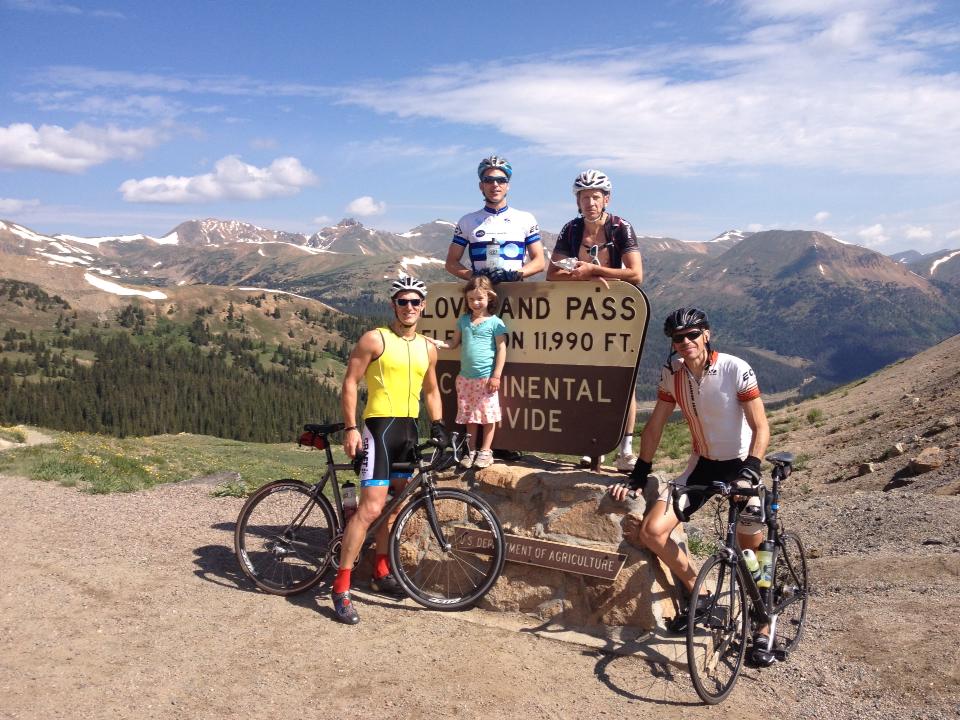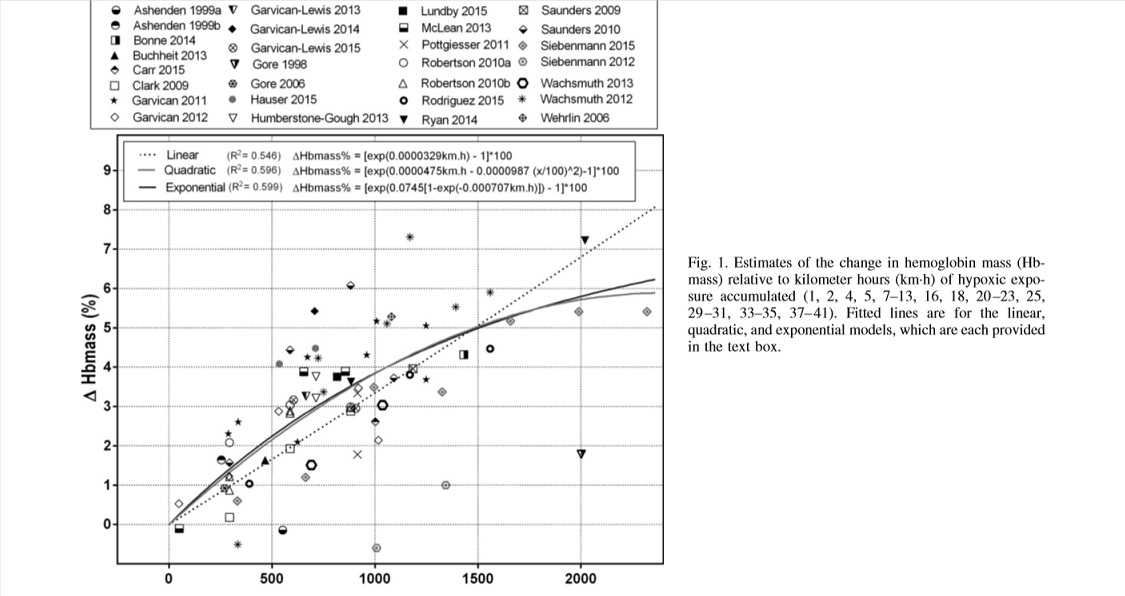Planning your altitude training 'dose'
Alan Couzens, M.Sc. Sports Science

Just us and the mountain goats :) - me and some fellow crazies getting the work done up high (& having a great time in the process!)
It seems that over the past couple of years, the interest in the use of altitude training has really increased. Perhaps it's because I'm an exercise physiologist who calls the highest state in the nation home (mean altitude of 2000m/6600ft), but the number of athletes reaching out to me on the topic has definitely increased of late. And, not only at the pro level of the sport where it has been a staple for many years but now, as the level of competition at the top of the age-group ranks increases, coupled with the cost of altitude tents coming down, I'm seeing a real boost in the interest of how to go about incorporating altitude blocks in your training program.
As Yann LeMeur's great infographic on the topic suggets...
Does #AltitudeTraining 'work'? YES! Providing appropriate monitoring/support takes place and it is optimized to the *individual* (elevation, duration, intensity & time at sea level before competition) https://t.co/x47XEHozeQ
— Alan Couzens (@Alan_Couzens) February 8, 2018
...providing the altitude is individualized and the athlete's health is monitored, there are significant benefits to altitude blocks for almost all athletes. In my experience, this is especially the case for long distance endurance athletes.
While VO2max may or may not show a significant bump after an altitude block (due to detraining of the other 'top end' factors that contribute to VO2max), given the right approach, submaximal numbers almost always improve at a rate well above and beyond what the athlete might expect from the pure training load. And the reason is basic math:
Each g of hemoglobin carries 1.37ml of Oxygen (fully saturated) So, if an athlete increases hemoglobin mass from, say, 14g/100ml to 15g/100ml and they have a blood volume of 7L, this represents an increase in O2 carrying capacity of ~100ml of O2, or 7%. At a fixed O2 demand for a given pace, this means that it will take ~7% less beats per min to get enough O2 to the working muscles! So, if a given pace or power output took 140bpm before altitude, it will be down to ~130bpm for the same pace/power after a good altitude block!
It goes without saying that a 7% increase in power for a given heart rate is VERY practically significant for a long duration sport like Ironman where the overriding goal is to hold high sustained power at relatively low heart rates! In 'normobaric' circumstances, it could take an athlete 6 months or more to accrue the same gains from training alone, so I think of altitude blocks as a 'turbo boost' of sorts -- very powerful, but to be timed right and used judiciously, with care.
One of the big limiters in the past for high level working age-groupers has been the duration of altitude exposure necessary to bring about a hemotological response. At the elite level, regular altitude excursions are common. For example, during my work with the Aussie swim team in the lead up to the 1996 Olympics, the team had no fewer than 3 'full time' 4 week camps in the year leading into the (sea level) games! However, in the working world, most athletes are vacation-time limited to an altitude 'training get-away' of 2 weeks or less & the research has been pretty clear in requiring a longer exposure of 3-4 weeks in order to start realizing the physiological gains of being at altitude. I personally think that this reason alone has really confined the widespread use of altitude training to the elite/professional athletes who can afford to be away from home 'on camp' for 4 weeks or more.

However, that is becoming less of a limiting factor these days as a) job flexibility increases and b) the technology on tents (like the Hypoxico model shown on the left) is going up and the price point is coming down to the point that they are rapidly becoming a viable stand-alone or supporting option to altitude getaways, at least for short periods (generally until the sleeping partner shuts that stuff down! :-) Additionally, many of the tent companies are offering rentals which is often a great option as the best use of simulated altitude is in focused blocks. Alternatively, if you have a crazy buddy or 2, another great option is to go in together on a tent and 'rotate custody' through the important blocks.
With the above in mind, I'm seeing that these days, it's becoming more the case that, rather than altitude being restricted to a designated extended camp, it's more a 'pot-pourri' of assorted exposures of different types and durations inserted within the season. Now, altitude is a complex enough stimulus to begin with, but when we start to mix in all of the various types (live-high-train-low/sleeping in tents, intermittent exposures - resting and training, stays at 'true' altitude etc.), the puzzle becomes even more complex.
Fortunately, the altitude research, which began in earnest in the 80's has reached a good level of maturity, to the point that, as in many fields, much of the new research takes the form of meta-analyses of the old research. One of these papers, in particular, proves very useful in solving the puzzle of putting different types of altitude exposure together within a periodized year to affect a good physiological response.
The 2016 paper titled "Time for a new metric for hypoxic dose?" introduces a new way of looking at altitude exposure that can bring different altitudes and exposure durations together in one common unit - kilometer/hours e.g. 500 hours (21 days) of exposure at 2000 meters of altitude would amount to 1000km/hrs (500hrs x 2km)
Beyond introducing this metric, they looked back over 27 altitude research studies to develop a dose-response model of the average Hemoglobin mass (Hb mass) gains for the various kilometer/hour combinations. A chart of this model is shown below...

The exponential dose-response model was the most accurate and explained ~60% of the variance in scores. In summary, the model showed an increase in Hb mass of ~2% at 500km/h, 4% at 1000km/h and 6% at 2000km/h with diminishing improvement beyond that. You'll notice that I say 'diminishing'. Another paper that looked at repeated altitude exposures (8 camps over 4 years) showed an ~10% total gain in Hb mass over that time. So, this is not a 'one and done' strategy. There is benefit to continued periodic inclusion of these altitude blocks through the training year. But looking at the single 'dose' of 2000km/h, going back to our physiological model above, an 'average responder' can expect a 6% increase in Hb mass which can amount to a saving of 10bpm for a given power output or, looked at the other way, a jump in Ironman power of 15-20W on the same heart rate!
The variance in the model should be noted. The biggest problem with most studies to date is that they occur at a fixed altitude so they typically yield a group of 'responders' and 'non-responders'. In order to ensure the best response for you, the altitude needs to be planned according to the particular desaturation levels of the individual athlete. This is another reason that a 'combo' approach of simulated and 'real' altitude, as outlined below, works really well - with a tent, you can get a sense of what altitudes lead to the 'right' range of desaturation for you and then plan any altitude excursions accordingly.
The use of this base metric of kilometer hours allows us to compare the combined effect of different altitude strategies, e.g. 50 nights of 10hrs in a tent at 2000m = 50 * 10 * 2 = 1000km.h (or a predicted 4% bump in Hb mass). Or a more intensive 21 day full-time camp at a 'real' 2000m altitude = 21 * 24 * 2 = 1008km.h - a similar (& some would argue, more enjoyable :-) dose.
For ease of assessment of the various strategies, I've put the above data into a simple calculator below...
| Hours | |
| Altitude (m) | |
| Predicted Hb Mass Gain (%) |
By referring the above, you can begin the process of 'dialing in' the dose of a particular method - both the duration of the exposure 'block' and the elevation that leads to a worthwhile increase in Hb mass. This 'common currency' also opens up the opportunity to combine methods, which in turn becomes a viable strategy for the working athlete who may be a little too 'vacation day poor' to go to altitude for a full 3-4 weeks, i.e. they could potentially do something like the following...
- 30 days of sleeping in the tent going in at an avg of 2000m as both an acclimation/initial altitude stimulus
= 30 * 8 * 2 = 480 km.hours plus... - a 12 day training camp at 2400m altitude
= 12 * 24 * 2 = 576 km.hours
to rack up 1056 kilometer hours (& a predicted ~4% Hb mass bump) for the altitude block.
The above combo, when available, has been the sort of strategy that I've been advising of late. Not only does it lead to greater total gain but it also eliminates the need for an extended period of acclimation at the start of the altitude training block, after travel. Generally, in the elite camps, the first week is pretty gentle and represents a (often frustrating) acclimation week. We can do away with that with the tent lead-in.
While, I don't like to compare altitude exposure with rhEPO, the mechanisms of improvement are essentially the same (although somewhat different in magnitude). I say somewhat different because the true potential benefit of rhEPO in cycling was 'capped' when the UCI instituted the 50% hematocrit rule in the mid 90's. Depending on starting hematocrit, it's not infeasible to elicit gains approaching the capped 50% HCT via multiple altitude exposures over a number of years. The larger point being that, at the highest levels of the sport, it's becoming tough to compete with those who are including altitude cycles in their program, and it's probably been that way for a few years now at the elite level of the sport! But, the big current shift, due to the factors mentioned above, is that it's now also becoming the case at the highest amateur levels of the sport.
This is a long way of saying that if you truly want to be competitive at the highest level, you should definitely consider including some good 'doses' of altitude (whatever the form) in your prep.
Train smart,
AC
TweetDon't miss a post! Sign up for my mailing list to get notified of all new content....
